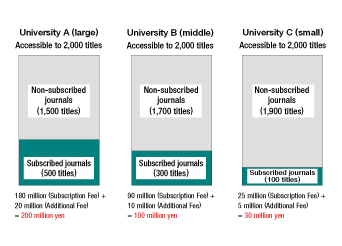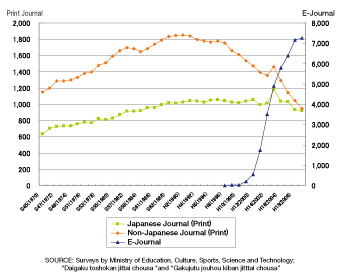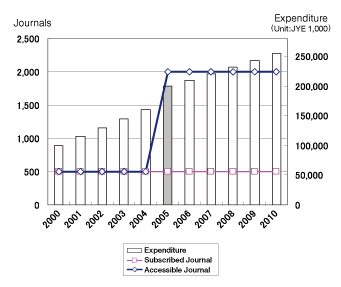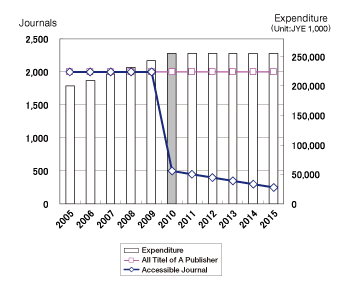Koichi Ojiro
(The University of Tokyo Library)
● Introduction
Is the Big Deal the most favorable licensing model for university libraries? The answer is yes and no. This paper examines perplexing issues around the Big Deal with reference to the efforts and steps taken by The Japan Association of National University Libraries.
● What is the Big Deal?
 Figure 1: The Big Deal Pricing Model
Figure 1: The Big Deal Pricing Model
The Big Deal is an electronic journals licensing model in which valid users can get access to all of a commercial publisher’s e-journals. It is also referred as a bundled package deal. For example, Elsevier provides about 2,000 titles of e-journals and if your library signs the contract called “ScienceDirect Freedom Collection” (Elsevier’s Big Deal) all the authorized users of your institution can access all that 2,000 titles.
Then, what is the pricing structure of the Big Deal? If a university library agrees to pay an additional charge for electronic access to the non-subscribed titles when it signs on to the Big Deal with the publisher, it gains right of access to all the e-journals of the publisher. How much the extra payment would be is decided on the basis of the amount that the university library currently pays for the journals it subscribes to. The annual price of the Big Deal is increasing every year. This is the basic structure of the Big Deal pricing although there are some differences depending on publishers.
It is often misunderstood that the Big Deal is a full-package of all the journals of a publisher with previously fixed price. We have to understand rightly that the point of the Big Deal is that the publisher offers you comprehensive right of access to all the titles with your paying some increment plus the current payment to the publisher.
In order to get a more concrete image of the Big Deal pricing model, I will explain this using a figure (Figure 1).
- A large-scale university A used to subscribe to 500 titles of journals of a publisher. The subscription fee was 180 million yen. A University has agreed to pay additional 20 million yen so that its users can access all 2,000 titles.
- A middle-scale university B used to subscribe to 300 titles paying 90 million yen. B University pays another 10 million yen, in total 100 million yen so that its users can access all the titles.
- A small-scale university C used to subscribe to 100 titles paying 25 million yen. C University pays another 5 million yen so that its library users can access all the titles.
These examples show that the price of the Big Deal of the same publisher differs greatly depending on universities. The amount of subscription fee paid when the Big Deal is signed on affects how much the additional payment would be.
● Consortium and the Big Deal
 Figure 2: Average Number of Annual Subscriptions to Journals in National University Libraries
Figure 2: Average Number of Annual Subscriptions to Journals in National University Libraries
Because of the serials crisis which began in 1980s and the increasing number of e-journals which grew at an accelerated pace in 1990s university libraries have adopted the strategy of establishing a consortium to purchase electronic journals jointly. For libraries the aim of this strategy is to try to strengthen the bargaining power against publishers by being united as a consortium.
Japanese National University libraries began some experimental attempts of collaborate purchasing e-journals in the latter half of 1990s. In September 2000 after the preparatory stage Japan Association of National University Libraries (JANUL) formed the Electronic Journal Task Force as the focal point of negotiation on behalf of national university libraries in Japan. The two main missions of the Electronic Journal Task Force are to set up infrastructures for academic information/communication by establishment of the stable system providing electronic information resources including e-journals and to reduce information gaps within and among universities. The Task Force earnestly has promoted various activities to achieve these two missions.*1
During the last decade the access environments for e-journals in national universities have greatly improved by establishment of joint purchase system in consortium, governmental pump-priming support funds and consolidation of segmented journal purchasing budgets within institutions.
Figure 2 shows the average number of annual subscription of print journals at national universities since 1970. In the case of non-Japanese journals, the number peaked in 1990 and after that year it sharply decreased because of the serial crisis.
On the contrary, the number of subscribed e-journals has drastically increased since 2000 when consortium among national universities came into existence and in 2007 7,267 tittles on average became available at each university. The consortium agreements with major commercial publishers are basically the Big Deal. Therefore, the great increase in number of accessible titles of e-journals can be primarily attributed to positive adoption of the Big Deal.
The benefit of the Big Deal has been remarkable especially for small-scale universities. Because it has become possible for their universities’ licensed users to access as many journals as large-scale universities’ users do by paying small amount of extra money. In this sense, the Big Deal is certainly the ideal model “to fill the information gaps among universities”.
On the other hand, the effect of the Big Deal for large-scale universities was not small. The greater the number of downloaded articles the lower the price per article has gone down year by year. What does seem sure is that the Big Deal is highly cost effective model of e-journals licensing.
Notes
*1 To get detailed information of consortium establishments by the Japan Association of National University Libraries, see the following papers and reports (all in Japanese).
- Sadao Uematsu. Daigakutoshokan niokeru denshi journal to sono tenbo. vol. 103, no. 11, Toshokanzasshi. 2009, p. 756-758.
- Kokuritsudaigakutosyokankyougikai denshi-journal taskforce. “Denshijournal Taskforce Katsudohokoku”. Kokuritsudaigakutosyokankyogikai, 2004.
- Kokuritsudaigakutosyokankyoukaigakujutsuiinkai. “Denshijournal Consortium Katsudohokoku”. The Japan Association of National University Libraries, 2009.
● The Problems of the Big Deal
However, purchasing the Big Deal has high risks attached. The biggest problem with the Big Deal is that its annual price increases every year. In the process of negotiation with publishers, consortium succeeded in placing price-cap to limit too much price increase. But given that the government-subsidized operating budgets for national universities have been dwindled every year, 5% rising rate of expenditure for journals in limited budgets is becoming a heavy burden and in the future definitely they will not be able to renew the Big Deal. Some of the universities already have started to think of discontinuing their agreements.
Another problem with the Big Deal is that the journal collection at university libraries could be disproportionate and unbalanced. Some people say only the publications from major commercial publishers might dominate the library collection because the Big Deal virtually deprive the right to select journals from the hands of libraries.1
A survey result that the above mentioned fear proved to be true was recently made in public by the Physical Society of Japan. The Committee of Research Environment in the Physical Society of Japan conducted the survey in the form of questionnaire to libraries of universities, junior colleges and technical colleges asking how they had been subscribing to 263 academic journals on physics. According to the result middle-scale and small-scale universities increased purchasing Pysica Series from Elsevier, Phys. Lett., Nucl. Phys. and EuroPhys. from Springer during the time from 2002 to 2006. In contrast, the small-scale universities decreased purchasing Phys. Rev. Series from APS and large-scale universities did so in purchasing J. Phys. Series from JPSP and IOP. On the basis of these results the committee pointed out that combined sales of journals by major commercial publishers obliged university libraries to accept bulk trading if some specific journals that libraries regarded indispensable were included in the package and that downsized budgets of libraries might have induced cancellations of subscriptions of journals by other publishers than those major commercial publishers. It also said that the total number of subscribed titles apparently increased, but in reality the essentially important academic journals seemed to be cancelled.2
● Dilemma about the Big Deal
 Figure 3: The Big Deal (Continuation)  Figure 4: The Big Deal (Discontinuation)
To highlight the problems in the Big Deal, I would like to give here a simple graphically-illustrated simulation both in the case of continuing and discontinuing the Big Deal.
| [In the case of continuing the Big Deal (Figure 3)] |
- Subscribed to 500 titles in 2000.
- Signed on to the Big Deal with extra payment in 2005. The total expense was 200 million yen.
The number of accessible titles increased up to 2,000 including non-subscribed journals.
- Given 5% price rising every year the total expense will be over 250 million yen in 2010.
- The journals that the library really subscribes to are 500 titles. The library has perpetual access right of these subscribed journals.
- The other 1,500 titles are non-subscribed journals and apparently they are accessible for library licensed users. But the library does not have post-cancellation access rights of them. Therefore at the expiry of the Big Deal they can no more access those non-subscribed journals.
|
| [In the case of discontinuing the Big Deal (Figure 4)] |
- Discontinued the Big Deal because of price increase in 2010.
- Then the 1,500 titles which were accessible before the expiry became inaccessible. The users of the university can access the rest 500 titles only.
- The prices of the 500 titles are increasing. If the budget is fixed in 250 million yen, the number of subscribed journals will decrease.
|
To sum up, libraries have to increase expenditure due to price increase by publishers if they want to continue the Big Deal to keep the same number of subscribed titles. When libraries discontinue the Big Deal and unless they enhance the budgets for journal subscriptions the accessible titles dramatically decrease. All-or-nothing choice. This is the biggest problem about the Big Deal.
● Seeking the middle course
Then how should we deal with this dilemma?
We have to choose whether to increase budgets for journals in response to the annual price rising of the Big Deal to keep the status quo or to stop purchasing the Big Deal and accept drastic decrease of accessible titles. Anyway we are facing rough passages.
To get rid of such a dilemma the consortia of The Japan Association of National University Libraries took a new step to orderly withdraw from the Big Deal agreements. In concrete terms they have began to seek the middle course between the Big Deal and individual subscription of each journal, considering options for new contract models including pay-per-view (per article).
However, is there the middle course through which we can orderly withdraw from the Big Deal? Moreover a new model could be a fundamental solution for various problems in the present scholarly communication systems? Unfortunately a possible new model to orderly withdraw from the Big Deal can be thought of no more than short or middle term solution and supportive measure. Even if libraries are able to adopt the new model of contract, so far as the serials crisis continues they can not avoid curtailment of journal subscriptions. So what we have to do is not only to consider the post-Big-Deal model of contract but also to make efforts from the long term standpoint to reform the present dysfunctional scholarly communication systems.*2
Notes
*2 About serial crisis, some reasons have been stated such as; (1) specific characteristic as commercial product, (2)increasing number of articles, (3)market domination by commercial publishers, (4) static demands to price increase, (5)development of new functions of electronic journals. See the paper below.
- Koichi Ojiro; Masahide Hoshino. “Gakujutsujouhoryutusystem no kaikakuwo mezashite: Kokuritsudaigakutosyokankyoukai niokeru torikumi”. Johokanri. vol. 53, no.1, 2010, p. 3-11. (in Japanese)
● Aiming at Reform of the Scholarly Communication Systems
The Japan Association of National University Libraries released the report titled “Statement for Reforming Scholarly Communication Systems: Aiming for sustainable provision of electronic journals as academic resources” (in Japanese) in April 2008.3 The report stated that the present contract model of e-journals would sooner or later break down and building up a new scholarly communication system was urgently required. And in March 2009 the Association presented “Statement on Open Access: Aiming for new scholarly communication system" (in Japanese)4 to appeal to those who are engaged with scholarly communication system to promote open access for sustainable scholarly information networks. Furthermore, it held the symposium for three times with the theme of “Towards the Reform of Scholarly Information Distribution during the year of 2008 and 2009, intensifying arguments about the issue. Based on these efforts the Special Committee on Reform of Scholarly Information Distribution was organized in 2009, which was an integration of some existing committees and working groups related to e-journals consortium activities. The committee is committed to building a next-generation scholarly communication system as well as negotiating with publishers. At the moment a roadmap for formulating and realizing the long-term vision to paradigm shift of scholarly communication system has been outlined.
(1) Phase 1 (- 2011)
- Continuation of the present Big Deal
- Examining the middle-term measures
- Starting to outline a vision for the next 10 years
(2) Phase 2 (2012 - 2019)
- Implementing the middle-term measures
- Experimental period of the vision for the next 10 years in a stepwise manner
(3) Phase 3 (2020 -)
- Realizing the new scholarly information system
The key to fulfill the goal of reforming scholarly information system in line with the above mentioned roadmap is how to implement the middle-term measures. The central point of them is building a safety net. To reform scholarly information system is nothing but to withdrawal from the Big Deal. In other words, as long as being engaged with the Big Deal we cannot take a challenging step to a new system. However if we discontinue the Big Deal a significant number of electronic journals will become inaccessible which our users could read. Strong backlash of faculty members and researchers is expectable. Such backlash might shake confidence in library’s cause to support the infrastructure of academic information resources. Actually to withdraw from the Big Deal is a difficult thing. “Saying is one thing, doing another” is the case with this issue. It is essential for university libraries to prepare a safety net that guarantees continuous access to indispensable journals for researchers after discontinuation of the Big Deal. Specifically, such attempts may be effective as efforts to plan a contract model to alleviate drastic decrease of accessible journals, to build a system in which all the university libraries can mutually use back files of e-journals and to organize an inter-library sharing system by recasting the role of the National Center for Overseas Periodicals (NCOP). It is an urgent task for the Japan Association of National University Libraries to build such a safety net and to improve the environment so that libraries can easily withdraw from the Big Deal.
As well as the middle-term measures the long-term vision for the next 10 years should be planned in a prompt manner. The important points to formulate the new scholarly information system are follows:
- transition of the present system overly dominated by commercial publishers to the one led by researcher community,
- separation of contents (articles) and services associated with them,
- creation of a mechanism to share the cost for scholarly communication system,
- uptake of the fruits of open access movements,
- new roles of libraries (consortia).
We will forge ahead with reform plans in keeping with efforts of Science Council of Japan and The Japan Association of National Universities to change the present system which is too dependent to commercial publishers and to realize a new system based on the research community.
● Conclusion
The Big Deal is an ideal contract model for a university library because it provides a large number of e-journal accesses at a relatively low cost. It is true that the information gaps among universities were greatly redressed by the Big Deal.
Whether to continue or discontinue the Big Deal depends on each university library. But it is clear that the Big Deal is not a sustainable contract model in long term. It is impossible to bring about fundamental renovation of scholarly communication system presently dominated by major commercial publishers without withdrawing from the Big Deal. Now it is the time when we have to combine the wisdom of all stakeholders towards the creation of new scholarly communication system.
|

